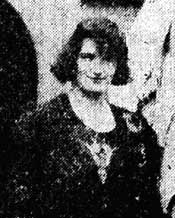
Peggy Medlar
1901 - 1939
Peggy was born Margaret Medlar on 23 April 1901 in Paulstown, Co. Kilkenny. Her father was a blacksmith in the town, as was his father before him. Peggy eventually came to Dublin, probably in her late teens, and set herself up as an Irish dancing teacher.
Dance School
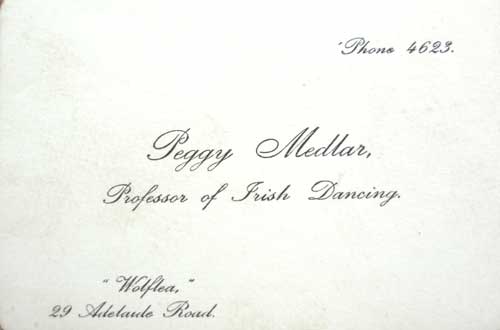
She worked both independently, starting at 63 Mountjoy Sq., and later with the Leggett Byrne's School of Dancing in Adelaide Rd.
By 1922 she was living in "Wolflea" 29 Adelaide Rd. She may have ended up in this building for two reasons. It is was near the Leggett Byrne's dancing school in No. 27 and the premises were occupied (1911) by John Lumsden, who was a banker, but whose wife came from Kilkenny. Peggy's cousin, PJ, was also living in this building between 1923 and 1927.
Peggy Medlar was well known in Dublin as the Irish dance teacher in Leggett Byrne's dance school at 27 Adelaide Road, Dublin. That family consisted of Talbot Byrne (b. 1867 in Dublin), his wife Mabel Leggett (b. 1866 in Southampton), both dance teachers, and their adopted daughter Beatrice (b. 1906 in London). The parents had married in 1890 and had no children of their own.
In October 1922 the Leggett Byrnes were thinking of leaving Ireland. I don't know whether this was because they might have felt uncomfortable in the new state or whether it was in response to offers from England. Perhaps it was simply that business in those troubled times was not what it had been previously. Concerned citizens organised a deputation to try and persuade them to stay and they must have succeeded as the Leggett Byrnes were still around up to 1932.
Peggy's younger sister, Josephine (aka Babe - born 1910), also came to Dublin and taught Irish dancing. Babe ultimately inherited the goodwill of the school after Peggy's death
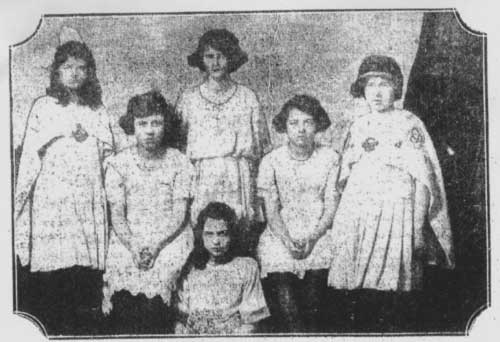
Peggy's winning troup in the Fairy Reel at the Father Matthew Feis in 1923
Medlar Feis
A competition purely for Medlar pupils was inaugurated in the CYMS Hall in Harrington St. in June 1921. On that occasion Fr. Xavier complimented her pupils "on having as their teacher, one of the greatest exponents of the art of Irish dancing".
By the following year the competition had moved to the Round Room in the Mansion House by which time the number of competitors reached 300. At the same competition the following year, also in the Round Room, Fr. O'Brien recalled that "when he had become first interested in it there were all men teachers of Irish Dancing. Miss Medlar opening as a dancing teacher was quite an innovation". By 1925 the Feis had moved to Parnell Square, on which occasion Mr. F. Fahey, TD, "expressed pleasure at Miss Medlar's decision to establish a class in which dancing would be taught through the medium of Irish".
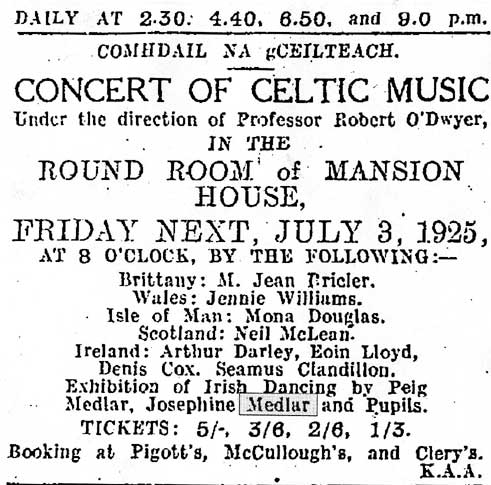
This Celtic Concert in the Round Room of the Mansion House in June 1925, sees Peggy, her sister Josephine, and pupils, filling the dance slot for the Irish delegation. I'm inclined to think of Celtic cooperation as a something that developed over the last 30 years, but it was clearly going on well before this.
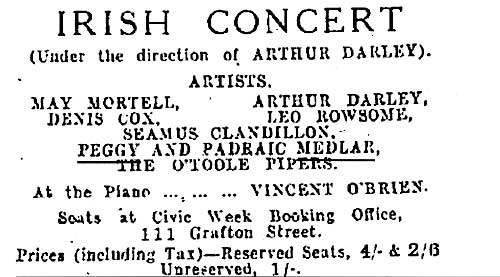
The above ad appeared in the Irish Independent of 17/9/1927. It advertises a concert for the 21st of September in the Mansion House Round Room. The concert includes Peggy herself and her older brother Padraic.
The concert was reviewed the next day in the Independent by H.R.W. who gave it a very good review. He commented that: "Mr. Darley selected only the best interpreters of Irish music and language. Hence the recital was on a distinctly higher level of excellence than is usual in entertainments of this peculiar kind". He lavished individual praise on most of the items, but when he got to Peggy and Padraic he showed his limitations as a reviewer: "Peggy and Padraic Medlar danced a hornpipe, but that is one of the many things about which I know nothing."
Negotiations were taking place in November 1932 to bring Irish artists, including Peggy, to the Chicago Exhibition the following year. I don't know what came of this but I am in correspondence with academics in the USA following it up.
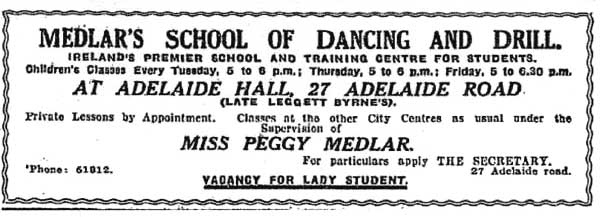
The ad above is from September 1933, by which time Peggy had clearly become the Principal of the school after the departure of the Leggett Byrnes..
Peggy was a member of the Imperial Society of Dance Teachers.
Arrest
Peggy was arrested by Free State Forces on 18 February 1923, at 29 Adelaide Road . She had in her possession letters and photographs which were judged to be incriminating and were duly confiscated. I recently gained access to them in the Military Archive in Cathal Brugha Barracks in the "captured papers" collection. From this, it is clear Peggy never got them back.
There were very few letters. It is possible she destroyed a lot of correspondence after getting a telegramme from Kilkenny, on 27 January 1923, telling her that her brother, Martin, who had been on the run, had been arrested by Free State Forces. Among the few letters were three very recent letters to Eileen Moylan. Eileen lived at 2 Park Grove, beside Portello (now Cathal Brugha) Barracks, where she worked. I wondered why Peggy would have these letters addressed to Eileen. Perhaps Eileen had been picked up and Peggy was taking her post. Or more mundanely, perhaps Eileen was simply on holiday. One of Eileen's letters was from a young man called Liam, from the Falls Road in Belfast, who was coming up to Dublin at the week end and was arranging a rendevous with Eileen at the Pillar..
I don't know what Peggy's connection with Eileen was. It could have been simple friendship, or had military connotations, or arisen from the Kilkenny mafia, as the house in Park Grove had been occupied by the Coffey family from 1912 to 1922, and James Coffey had been born in Kilkenny in 1861. Although Eileen's mother was living in Waterford, I gather Moylan is a Kilkenny name.
Most of the photos taken from Peggy were of young men, many of them sporting the F�inne (the old solid model). Again, the connection here could have been an Irish language or dancing one, or some of these may have been active in opposing the Free State Government. Many are studio photos but the men are not named, with one exception which is inscribed (see below). I will try and follow up this lead further in Irish language circles. Meanwhile I have incorporated some recent information in a post on my Irish language blog.
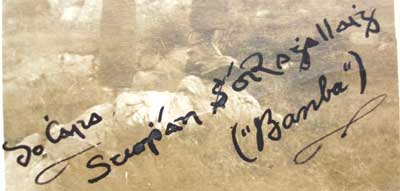
Do chara, Stioph�n S � Raghallaigh ("Banba")
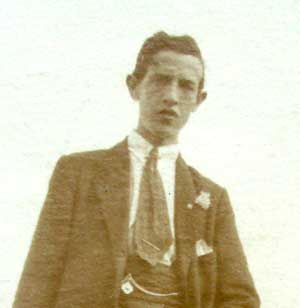
And this is Banba
While we're on this theme, I should digress for a moment to have a look at the republican activities of some of Peggy's siblings in her hometown of Paulstown, Co. Kilkenny.
Larry
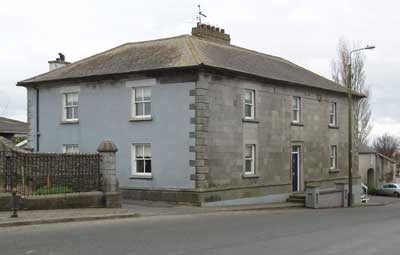
Laurence was born in Paulstown in September 1896. He was commandant of the No. 4 Battalion, Kilkenny Brigade, in the war of independence. In February 1921, he was arrested, accused of having 39 sticks of gelignite in his possession and having taken part in an attack on Gowran police barracks. He had also in his possession incriminating documents relating to the No. 4 Battalion, Kilkenny Brigade of the IRA. His defence, at a court martial in April 1921, was a combination of an alibi for the barracks raid (supplied by his father), mental incapacity (the doctor said he had a lack in him since a bout of flu two years earlier) and "minding the materiel for others" who had threatened him to silence.
The Court was not impressed and Laurence was sentenced to death. This was communted to 15 years penal servitude from which he was released on the signing of the Treaty. On 18 January 1922, volunteers and a large crowd welcomed him home from Waterford jail where he had been serving his sentence.
Meanwhile, in Dublin his cousin's undertaking business "Messrs. Medlar and Claffey, James's street placed their cars and brakes at the disposal of the released men and drove them home to the various districts round Dublin. Mrs. Medlar also entertained a number to lunch." TG4 video clip
However, after independence Larry became an "irregular" and spent much of the few remaining years of his life in internment. He died in 1929 from heart failure.
Martin
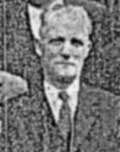
Martin was born in Paulstown in Decembere 1899 and he was also active in the war of independence. Like Larry he took up arms against the Free State Government in the Civil War. He went on the run but was captured and arrested in January 1923 (referred to above). In common with about one thousand other prisoners, he went on hunger strike in October/November of that year. Although the hunger strike was called off at the end of November, Martin was not released until July 1924. He subsequently became Secretary of the Paulstown Fianna F�il Cumann and was elected to D�il �ireann in 1957. He was a TD until his death in 1965.
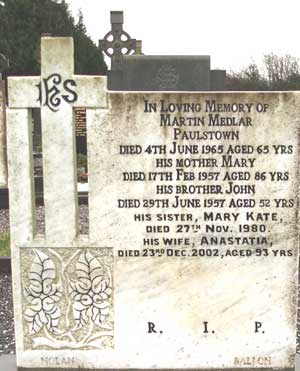
Marriage
In August 1935 Peggy was reported to be seriously ill in her people's home in Paulstown. This may have been the first onset of the TB that eventually killed her. She was nursed by her sister Bridie, who was a [nurse] in the Mater Hospital, Dublin. I'm told that, at some stage, Peggy spent time in Switzerland in connection with her TB. By September 1935 she was well enough to be bridesmaid at PJ's second wedding in Dublin, where she "wore a saxe-blue frock, with a short fur coat and a large saxe-blue hat".
She married Detective Sergeant Michael Lynch at the beginning of 1938.
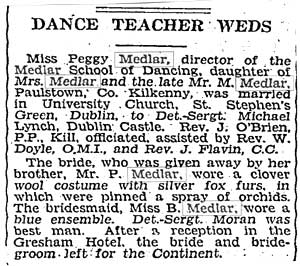
Irish Independent 30/1/1938
Death
Sadly, by early 1939 Peggy was critically ill with TB. In March of that year she made a will which is a very sad document to read. In it, each room in the house is inventoried and the contents assigned to different family members, principally her husband, sisters and brother in law. She left her mother a silver cup, an armchair, a share in ornaments and ashtrays, and a significant sum of money to be paid in instalments. Her interest (ie the goodwill) in the business of dancing and physical culture instructress went to her sister Babe (Josephine) while her interest in the premises itself went to her husband.
She also left a sum of money to one of her pupils, Peggy Dunne (who may have been related through Uncle Larry).
But the saddest and most touching indication of her state of mind at the time was the very large sum she left to Fr. O'Brien in Kill, Co Kildare, for public masses (50 in all), and the significant sum given to her brother in law for Gregorian masses to be said in Ireland or elsewhere. These were all for the repose of her soul.
She died on 29 July 1939, in her house and school in Adelaide Road, "to the inexpressible grief of her mother, husband, brothers and sisters". She was buried in the family plot in Paulstown, Co. Kilkenny.
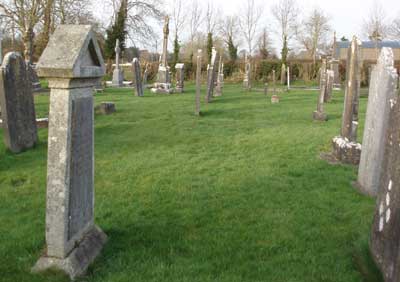
Unfortunately her grave, and that of the Medlars who died before her, is not marked in the local Paulstown Church. Apparently, some lunatic priest, in more recent times, decided to rid the graveyard of any damaged gravestones. While this caused major uproar at the time, they were not replaced. The picture above shows an approximate location for the Medlar family grave. You can see a conspicuous absence of gravestones in the centre area of the picture.
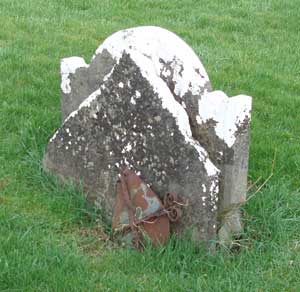
Perhaps Peggy's gravestone looked like this? I wonder did the mad priest miss this one or did some raging bull do for it since?
I wonder should I start a local petition to have the broken stones reclaimed from [Coleman's] field where I understand they were dumped.